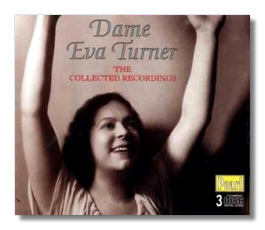
The Internet's Premier Classical Music Source
Related Links
- Latest Reviews
- More Reviews
-
By Composer
-
Collections
DVD & Blu-ray
Books
Concert Reviews
Articles/Interviews
Software
Audio
Search Amazon
Recommended Links
Site News
 CD Review
CD Review
Dame Eva Turner

Collected Recordings
- 41 recordings, 1926-38
Eva Turner, soprano
Various Soloists and Accompaniments
Pearl GEMS0094 ADD monaural 3CDs 73:51, 72:59, 53:54
EMI Classics released a single-disc Turner compilation several years ago. It is now out of print, however, and the present issue remains by far the best way to get acquainted with this very exciting British singer. Three discs might seem like too much of a good thing, but I was never frustrated by this set, even though it contains multiple versions of several arias. (There are three recordings of "Ritorna vincitor," four of "Vissi d'arte," and five of "In questa reggia.")
Turner was born in Lancashire in 1892, and she wanted to be an opera singer from the age of ten, when she saw Il Trovatore. She studied at the Royal Academy of Music in London, and got into a prominent touring company. At first she sang in the chorus, but by 1920 she was cast in leading roles. Her debut in Italy was encouraged by no less than Arturo Toscanini, and eventually she made her way to La Scala. She and Italy liked each other, and she sang her first Turandot just eight months after the work's 1926 première. This is the opera that has been associated with her more than any other and recordings of her 1937 performances at Covent Garden (partnered by Giovanni Martinelli, with Sir John Barbirolli conducting) are justly famous. Her voice rapidly deteriorated at the start of the 40s, and by 1948 her singing career was over. Her second career then began. She taught in the United States and in London (her pupils included Rita Hunter), and she remained very active well into her 90s. She died in 1990 at the age of 98.
She was a diminutive woman with a huge voice. Her very first recordings, made in Italy in 1926, can send shivers up your spine, not just with their theatricality, but also with the transfixing power, beauty, and accuracy of her singing. She cuts right through the limitations of the faded sonics with the astonishing purity of a laser beam. She was back in London in the summer of 1928, when she made her most famous studio recordings, with Stanford Robinson and Sir Thomas Beecham on the podium. These include "In questa reggia," "Suicidio!," "Vissi d'arte," "Voi lo sapete," "Ritorna vincitor," and "D'amor sull'ali rosee." If she had done nothing more than these six records, Turner's exalted place in singing history still would be secure.
The Covent Garden Turandot scenes from 1937 are here (two at 17 minutes each, starting with "In questa reggia.") There's also Vaughan Williams' Serenade to Music from 1938 (where her colleagues include Isobel Baillie, Heddle Nash, and Roy Henderson), and excerpts from a 1937 radio broadcast on Puccini, where Turner sings scenes from Madama Butterfly, La Bohème, and Turandot with the fine tenor Dino Borgioli. In terms of recording quality, these are the best things in Pearl's set, and it is a shame that Turner is a little under par here. This set also includes songs by Grieg, Tosti, and D'Hardelot, and arias by Wagner. Several of these recordings are acetates or test pressings that exist in only a single copy. In some cases, "first aid" was required to get these unique recordings to play. The transfers, by Roger Beardsley and Richard Bebb, are excellent, and the personal and very entertaining annotations are mostly by Bebb, who knew Turner since 1961.
If you love the sound of a great, and I mean great, dramatic soprano, Turner's your woman. Don't be intimidated by the size (and price) of this collection; the initial outlay may be a little painful, but you will get unparalleled enjoyment from Turner's voice. When EMI released its compilation, I hesitated… and was lost. (Miraculously, I tracked down a used copy two years ago.) Don't make the same mistake I did, or you will kick yourself.
Copyright © 2000, Raymond Tuttle


















